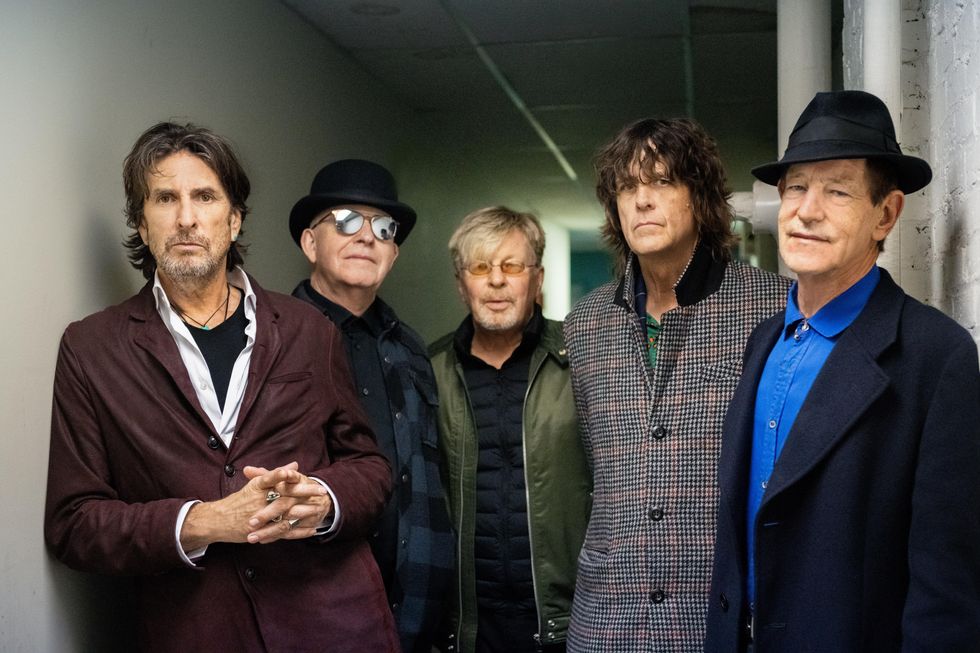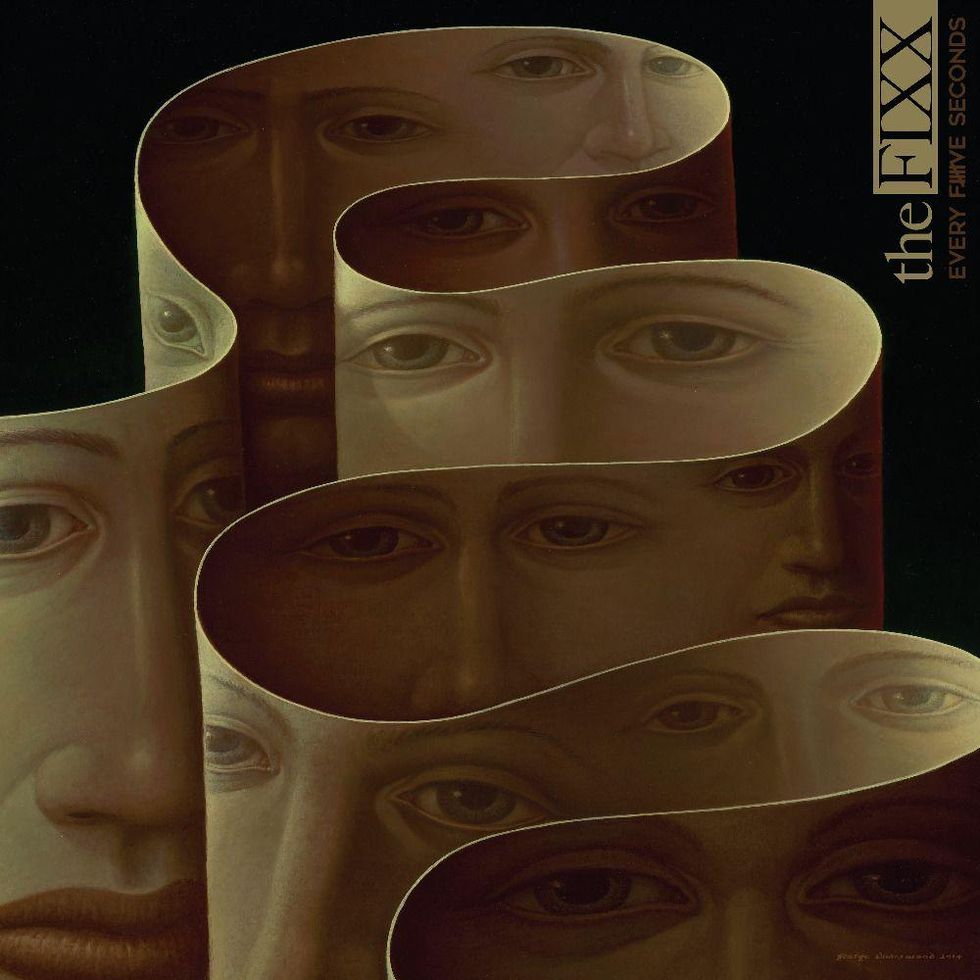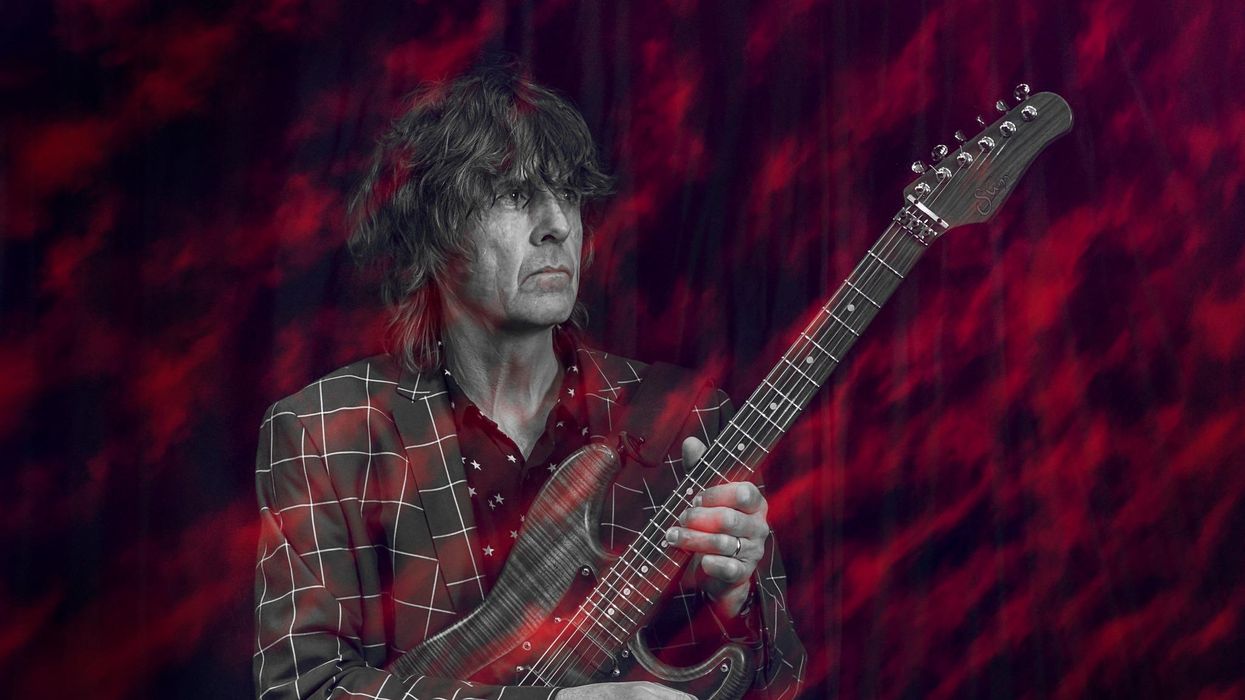When it comes to influential ’80s guitarists, it’s easy to fixate on the likes of Van Halen, Vai, Satriani, the Edge, Stevie Ray Vaughan, Johnny Marr, and Eric Johnson. But the chiming, simultaneously funky and moody rhythm work of Jamie West-Oram, from British synth-rock outfit the Fixx, is similarly singular. He isn’t just a rhythm ace, though. Highly compressed, often drenched in reverb and/or subtly swirling modulation, West-Oram’s syncopated Strat leads and quirky whammy flourishes melded like clockwork with big bass lines and atmospherically bastardized synth pads to define inescapable radio hits of the decade like “Red Skies,” “Stand or Fall,” “One Thing Leads to Another,” and “Are We Ourselves?”
Thing is, he wasn’t even playing a Strat. It was a Schecter “partscaster” (with passive EMG pickups) put together for him by John Suhr during his days at Rudy’s Music in New York City. In fact, until a fateful concert made West-Oram an S-style convert, he was more a fan of Gibson single-cut rawness. The Fixx’s stellar debut, 1982’s Shuttered Room, was largely recorded with a P-90-equipped Les Paul Jr.
Every Five Seconds
But a London-based jazz-fusion guitarist put him on a different tonal path. “There was a guy called Murphy who was just a brilliant guitar player,” he remembers. “I went to one of his gigs and was totally knocked out by his playing and sound. I said to my mate, ‘He’s getting a great sound out of that Fender.’ And he says, ‘It’s not a Fender, it’s a Schecter.’ I thought, ‘If I get one of those, I’ll sound like that.’ But of course, it doesn’t work that way.”
Since then, West-Oram has expanded to similarly equipped koa-bodied Suhr “super strats” with Floyd Rose vibratos and active EMGs, as well as a trusty Fender ’62 Strat reissue with signature pickups by Dave Walsh at Eternal Guitars in Chichester, U.K. However, as evidenced on the band’s 13th full-length release, this year’s Every Five Seconds, he remains a fan of Gibson-built single-cuts. For rawer tones on tracks like “Cold,” he used a two-pickup ’61 Epiphone Olympic (a recent gift from his wife, Bibi) through a couple of “just blisteringly good” early-’60s Vox AC30s that were on hand at Panic Button Studios in West London.
Cy said, “Less U2, more New York Dolls,” and I went, “Ah, that’s it. Now we got it!”
Trans-Atlantic Tone Trades
For many of the Fixx’s early years, West-Oram relied on 50-watt tube combos from another famous British amp brand—Marshall. Then, as now, he was running a stereo-amp rig in order to make the most of the stompbox that’s been a secret weapon since he bought it new in 1981. “When I first joined the band, I had one of the [Marshall] combos, and then I got the [MXR] Stereo Chorus and went, ‘I’m gonna have to get another amp—because this doesn’t sound good with just one amp!’ I used those two combos on the first Reach the Beach [the band’s 1983 sophomore album] tour. The next year, our stage manager took the heads out and put them into a rack, along with various other things. I typically turned the master full up and the preamp up just enough for it to start getting interesting.”
Despite his appreciation for classic British amps, West-Oram has been relying primarily on Fender Hot Rod DeVille combos since Fixx vocalist Cy Curnin turned him on to them roughly 20 years ago. “I like the tone of the Fenders—the clean sound.” He adds, “And I know I can always get the Fenders if we have to rent backline.”

The Fixx (L to R): vocalist Cy Curnin, bassist Dan K. Brown, drummer Adam Woods, Jamie West-Oram, and keyboardist Rupert Greenall.
Photo by Liz Linder
As you might expect, that means he depends on pedals to muck up his tones. Live, he’s recently been using an Xotic SL Drive for dirt—although for the Five Seconds sessions he used an Ibanez Tube Screamer. “Otherwise, I used pretty much the same gear that I use live. I’ve got the Suhr Koji Comp compressor, which is on probably 50 percent of the time. Back in the olden days, I’d have everything on all the time—it never occurred to me to bypass them! [Laughs.] Now, I bypass them so they sound more exciting when they do come in.” A Boss DD-500 delay is another go-to. “It can do a whole whack-crazy amount of things, though my presets are mainly based on tempo and varying the modulation of the delay. So, you can have a straightforward delay, or you can have a slightly seasick delay or change the actual tone of the delay signal. I’ve also got an old Electro-Harmonix Memory Man, which sounds really sick, but it’s too big to fit on my pedalboard. I use that for recording at home.”
A First … and a Way to Last?
Asked what he attributes the punch and vitality of the new Every Five Seconds songs to, West-Oram says it was a slight tweak to their recent songwriting approach. Whereas the synth-rock quintet had been sending each other song ideas across the miles for other recent LPs, most of the new album’s basic writing was done in person, in real time. “It was more like when we did ‘One Thing Leads to Another,’ where we were all in the room together and we just knocked it out in a couple of hours.”
Five Seconds is also notable for West-Oram because the alternatingly lilting and primal “Woman of Flesh and Blood” marks his first time singing lead on a Fixx track. “We were having rehearsals and one day I showed up and went, ‘I’ve written a song and I’ve done a demo of it. Would you like to hear it?’ One of them probably said, ‘No, I want to hear you play it and sing it live.’ So, I went for it, and they all liked it and thought we should pursue it. I assumed Cy would end up singing it and maybe changing the words completely, but he said, ‘You should sing it,’ and he just added words it needed, because it wasn’t quite complete.”
Jamie West-Oram’s Gear

The guitarist boldly strikes a chord on his green Strat during a June 2022 show at Los Angeles’ El Rey Theatre.
Photo by Debi Del Grande
Guitars
- Suhr koa S-style (“Woody”) replica of ‘84 Schecter “partscaster”
- Suhr Classic T
- Fender ‘62 Stratocaster reissue with signature pickups by Dave Walsh
- 1961 Epiphone Olympic
- Ernie Ball Music Man Axis Super Sport
- Early-’80s Ibanez Blazer (used on original “One Thing Leads to Another” tracks)
- Custom 1991 Ibanez S-style
Amps
- Two Fender Hot Rod DeVilles running in stereo
- 1962 Vox AC30 (studio)
- Suhr Corso (studio)
- Cornell Plexi (studio)
- 1964 Elpico 18-watter (studio)
Effects
- 1981 MXR Stereo Chorus
- Suhr Koji Comp
- Suhr Shiba Drive
- Suhr Riot
- Xotic SL Drive
- Vemuram Jan Ray
- Boss DD-500
- Boss SL-20 Slicer
- Boss volume pedal
- Assorted pedals (studio)
Strings & Picks
- Ernie Ball Burly Slinkys
- Jim Dunlop 1 mm picks
West-Oram says the previous scenario’s humor, openness, and encouragement are indicative of what’s enabled the band to weather more than 40 years together. “I mean, there’s, y’know, five men of a certain age living together on a tour bus for a couple of months—a couple of us with wives or girlfriends—all getting up at different times of the day and crashing out at different times of the day … stumbling through the bus corridor and tripping over shoes and things like that. It’s like any dysfunctional family. We all have a good sense of the ridiculous, and we can make fun of each other and get away with it. That usually overcomes any personal things.
“I think the key to staying together is just being really upfront and honest with each other, and being professional. Show up on time for rehearsals and soundchecks and gigs. Those are the obvious things. But also, just realizing that the whole thing is much bigger than that. What you have to offer as a band is a lot bigger than the minor personal things that come up. The enthusiasm from any one of us is going to rub off on the others. So, if one of us says, ‘I’ve got this experiment I want to conduct and it goes like this,’ and there’s an enthusiasm, we’re all gonna go, ‘Great! You’re really into that, so do it. Let’s all ride that wave of enthusiasm and see where it takes us.’”

Encouraged by vocalist Cy Curnin, Jamie West-Oram stepped into the Fixx’s lead vocal chair for “Woman of Flesh and Blood,” a first for the guitarist.
Still Riding New Waves
To illustrate how this collective openness plays into the band’s contemporary songcraft, West-Oram points to Five Seconds tracks “Suspended in Make Believe,” where gently swinging drums and pianistic bass lines undergird spare, trem-treated open-position chords, ethereal strings, and contemplative lyrics, and “Neverending,” which opens with “acoustic” guitars pounding out an insistent-but-open-feeling groove that’s tightly syncopated with the drums.
Back in the olden days, I’d have everything on all the time—it never occurred to me to bypass them!
“For a ‘typical’ Fixx song, you might expect a solid, sync’d rhythm section, chiming guitars, animalistic keyboard sounds, and strong vocals,” he begins, “but I don’t think we dismiss an idea because it doesn’t sound like ‘a Fixx song.’ We might actually lean more towards one that isn’t an obvious Fixx song. There’s a couple on the new album that aren’t what we’d normally do, and because of that, rather than despite that, they made it to the album. On ‘Suspended in Make Believe,’ there’s aren’t any chiming guitars, and I ended up with a very strange sound. I have this Music Man guitar, an Axis Super Sport, with a piezo pickup so you can make it sound like an acoustic. I plugged that straight into a Fender amp and cranked it up. It’s got quite a strange, slightly grating sound. There’s also one called ‘Neverending,’ which almost has this arena-rock thing. It was starting to get a little bit Bruce Springsteen and, I mean, he’s great—but that’s not us. And then it started to get a bit U2-ish and we didn’t want that either, even though they’re great as well. And then Cy said, ‘Less U2, more New York Dolls,’ and I went, ‘Ah, that’s it. Now we got it!’ It’s not really like the New York Dolls, the way it ended up, but little comments like that can knock you sideways in a good way. Then you end up following it down another rabbit hole.”
The Fixx - Live In The USA (The Bayfront Theater, Florida, 27-11-1984)
At 48:00, the crowd goes crazy as West-Oram and crew launch into “One Thing Leads to Another” in this live clip from 1984.






![Rig Rundown: AFI [2025]](https://www.premierguitar.com/media-library/youtube.jpg?id=62064741&width=1245&height=700&quality=70&coordinates=0%2C0%2C0%2C0)












 Shop Scott's Rig
Shop Scott's Rig
![Devon Eisenbarger [Katy Perry] Rig Rundown](https://www.premierguitar.com/media-library/youtube.jpg?id=61774583&width=1245&height=700&quality=70&coordinates=0%2C0%2C0%2C0)












 Zach loves his Sovtek Mig 60 head, which he plays through a cab he built himself at a pipe-organ shop in Denver. Every glue joint is lined with thin leather for maximum air tightness, and it’s stocked with Celestion G12M Greenback speakers.
Zach loves his Sovtek Mig 60 head, which he plays through a cab he built himself at a pipe-organ shop in Denver. Every glue joint is lined with thin leather for maximum air tightness, and it’s stocked with Celestion G12M Greenback speakers.













 Luis Munoz makes the catch.
Luis Munoz makes the catch.






